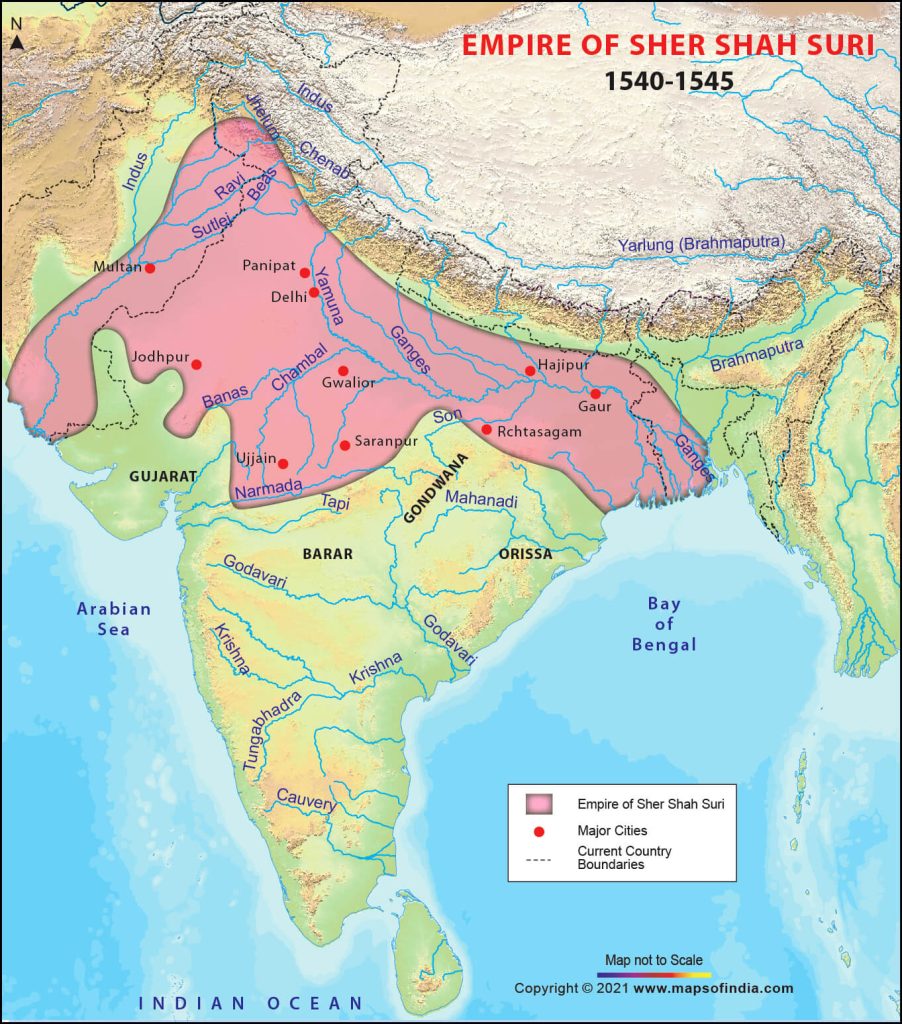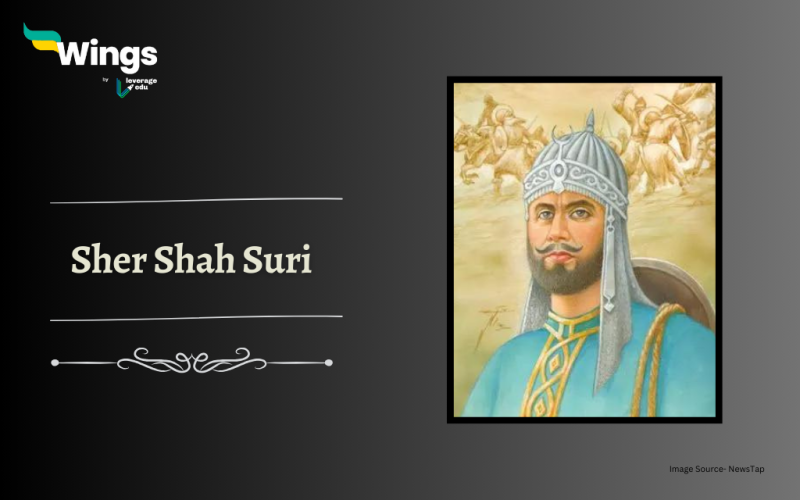Sher Shah Suri, also known as Sher Shah of Sur and called the “Just King”, was one of the most renowned rulers in the medieval history of India. Born as Farid Khan, he ascended the throne in 1540 and ruled until his death in 1545. He was known for his vision and progressive policies, Sher Shah Suri made significant contributions in various aspects of governance and infrastructure development. In this article, we will delve into the life, history, policies, administration and rule of Sher Shah Suri, highlighting his remarkable achievements and lasting impact on Indian history.
Table of Contents

About the Early life of Sher Shah Suri
Sher Shah Suri was born in 1486 in the present-day Sasaram district of Bihar. He belonged to a Pashtun tribal family and was known as Farid Khan during his early years.
- During his youth, Farid Khan took refuge in the Dehri Fort due to a family dispute. This is where he gained his first taste of political intrigue and military strategy.
- Initially serving as a private soldier, Sher Shah Suri displayed exceptional military skills and rose through the ranks to establish his authority in North India.
- Sher Shah earned the moniker “Sher” (meaning “lion”) due to his bravery and ferocity on the battlefield. This title became synonymous with his legacy.
Also Read – Sayyid Dynasty: UPSC Notes, History, Architecture, Economy
What is the Historical Significance of Sher Shah Suri’s Reign?
He was the founder of the Sur Dynasty and was the second Afghan Empire which was established after the Lodhi Dynasty.
- Rise to Power: Sher Shah initially served under various rulers including the Mughals, until he formed his own independent kingdom by defeating Humayun, the Mughal emperor, in the Battle of Chausa in 1539.
- Defeat of Humayun: Once again, in 1540, Sher Shah Suri defeated the Mughal emperor Humayun in the Battle of Kannauj which led to his own ascension to the throne.
- Construction of Royal Road: One of his remarkable achievements was the construction of the Grand Trunk Road also known as “Sadak-e-Azam.” Stretching over 1,600 miles, this road connected the major cities, facilitating trade and communication throughout the empire.
- Introduction of Coin: He introduced the new silver coin named “ Dam”. And they ere in circulation till 1835. It is believed that
- Justice System: The emperor’s rule was known for its impartial and efficient justice system. He established a network of courts and introduced the concept of Qazis (judges) to ensure fair trials and efficient dispensation of justice.
Policies of Sher Shah Suri
During his rule, he introduced many policies for his dynasty to excel well. Some of them are –
- Land Reforms: Sher Shah implemented several land reforms to alleviate the plight of farmers. He introduced the system of measurement of land known as “Gaz-i-Sher Shahi,” which helped in accurate taxation and assessment. Also, the land was measured as Sikandari Gaz (32 points).
- Revenue and Taxation: He abolished the oppressive taxes and introduced a new system called “zabti-i-har-sal,” which involved regular assessment and collection of revenue. This ensured a fair and transparent taxation process.
- Irrigation Projects: To boost agriculture, Sher Shah initiated several irrigation projects, including the construction of dams, canals, and reservoirs. This led to increased agricultural productivity and improved the lives of farmers.
- Postal System: Recognizing the importance of communication, Sher Shah introduced an efficient postal system known as “Darogha-i-Dak Chauki.” This facilitated the exchange of information and enhanced the administration’s efficiency.
- Infantry Reform: He maintained his personal royal force and called it Khasa Kail. He was also inspired by Allauddin khilji and branded his horse following his footsteps.
Also Read – Tughlaq Dynasty: Rulers of Delhi Sultanate
Administration under Sher Shah Suri
He continued the central administration which was followed in the Sultanate Period.
- To aid him, he was accompanied by 4 important officials namely –
- Diwan -i- Wizarat/Wazir – Revenue and Finance.
- Diwan-i- Ariz – Army Incharge
- Diwan- i -Insha – Minister of Communication
- Diwan-i- Rasalat – Foreig Minister
- Barid – Intelligence.
- His empire was divided into “Sarkars” and had Forty-Seven Sarkars.
- Each Sarkar was again divided into various Parganas.
- For each Parganas, various in-chargers were placed like-
- Shiqdar – Military Officer
- Amin – Land Revenue
- Karkuns- Accountants
- Fotedar – Treasurer
- Chief Shiqdar – Law and Order and
- Chief Munsif – Judge
- Mauza – Village was the lowest level in terms of administration.
- The administrative Units were called Iqtas
- He introduced Patta, the amount that each farmer has to pay.
- He also introduced Qabuliyat which was the deed of agreement.
Sher Shah Suri’s reign occupied the whole of North India except Nepal, Assam, Gujarat and Kashmir. Although his reign was cut short due to his untimely demise in 1545, he ruled for only 5 years, but his successors ruled for 15 years. He was succeeded by Emperor Akbar, when the Sur’s Wazir, Hemu was defeated in the Second Battle of Panipat in 1556.
Relevant Blogs
| Khilji Rulers | Muhammad Ghori |
| Qutubuddin Aibak | Babur |
| 50 Interesting History Facts | The Vijaynagar Empire |
| Ibn Battuta | Mughal Emperor Jahangir |
| Emperor Aurangzeb | Chola Dynasty |
We hope you liked our blog. If you want to read more articles like this you can visit our general knowledge page on Indian History!
 One app for all your study abroad needs
One app for all your study abroad needs













